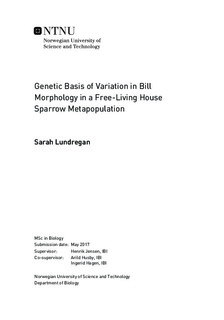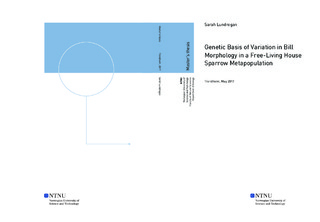| dc.description.abstract | Bill morphology is an ecologically important trait, which shows substantial phenotypic variation, is highly heritable and is under selection in many bird species. These characteristics underscore the suitability of bill morphology traits for gene mapping analysis and increase the probability that evolution of these traits will occur at a rate conducive to generation of ecological and evolutionary (eco-evo) feedback. Knowledge of the underlying genetic architecture of bill morphology is required to understand the mechanisms driving phenotypic change in these traits and to interpret their involvement in eco-evo cycles. Previous studies have revealed several genes which may influence bill morphology but total number of causal loci, their locations in the genome and magnitude of their individual effects is unknown. Here, the genetic basis of four bill morphology traits (bill depth, bill shape, bill length and bill size) was explored using phenotypic and genome-wide SNP data from a large-scale dataset from an insular house sparrow metapopulation off the coast of Northern Norway. Genomic heritabilities for the above bill morphology measures were estimated using variance component methods, proportion of variance explained was high and broadly in line with previously defined estimates. Chromosome partitioning analyses found significant, positive relationship between chromosome size and proportion of variance explained for the four examined traits, indicating a polygenic basis for bill morphology. Candidate gene and GWA methods were used to search for causal loci. No large effect was observed for any bill morphology trait in candidate gene regions, although weak association was detected for ALX1 and FGF8 for bill shape and size respectively. GWA analysis revealed a significant locus of small effect size on bill depth, situated approximately 1 Mbp away from CRIM1, which exerts upstream control over BMP4. Increase in bill depth with hatch year was observed in the Helgeland metapopulation, as was increase in the frequency of the allele conferring deeper bills at the significant marker. Bill depth may be under positive selection in this metapopulation or covariation of genetic change and environmental fluctuations may be driving its increase. This work illustrates both the difficulties and advantages of performing association studies in natural populations and attempts to determine which approaches may be most likely to result in detection of causal loci. | |

